story and photos by Kayte Deioma
The number one attraction in the Pasadena area other than the New Years Day Tournament of Roses is the Norton Simon Museum. This museum is home to the extensive works of art collected by industrialist Norton Simon between the 1950s and 1970s. He used some of the wealth he generated from his international consumer products companies to amass an amazing collection of art from Old Masters to contemporary artists. The current Norton Simon collection also includes works from the Pasadena Art Museum, which merged with the Norton Simon in 1974.
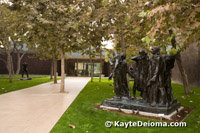 A visit to the Norton Simon begins before you even enter the building. The walkway from the parking lot traverses a garden of larger-than-life Rodin sculptures. The centerpiece of these sculptures is the Burghers of Calais, a sculpture of six men in ragged clothing with nooses around their necks. It was commissioned by the city of Calais to commemorate the brave act of these men in hostaging themselves to the King of England in order to gain freedom for their town in 1347. Before creating the final sculpture of the six men, August Rodin created studies of each individual nude and then clothed. Some of these full-size studies surround the Burghers of Calais in the front garden.
A visit to the Norton Simon begins before you even enter the building. The walkway from the parking lot traverses a garden of larger-than-life Rodin sculptures. The centerpiece of these sculptures is the Burghers of Calais, a sculpture of six men in ragged clothing with nooses around their necks. It was commissioned by the city of Calais to commemorate the brave act of these men in hostaging themselves to the King of England in order to gain freedom for their town in 1347. Before creating the final sculpture of the six men, August Rodin created studies of each individual nude and then clothed. Some of these full-size studies surround the Burghers of Calais in the front garden.
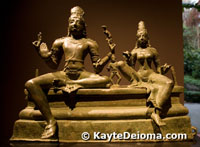 Inside, the Museum is divided into two levels. The main level or upper level houses European and American paintings and sculptures from the 14th century to the 20th century. Downstairs is Norton Simon’s extensive collection of South and Southeast Asian Art, which consists primarily of sculptures and architectural elements from India, Thailand, Cambodia, Tibet and other parts of Southeast Asia with just a few works on paper. The temporary exhibit hall is also downstairs.
Inside, the Museum is divided into two levels. The main level or upper level houses European and American paintings and sculptures from the 14th century to the 20th century. Downstairs is Norton Simon’s extensive collection of South and Southeast Asian Art, which consists primarily of sculptures and architectural elements from India, Thailand, Cambodia, Tibet and other parts of Southeast Asia with just a few works on paper. The temporary exhibit hall is also downstairs.
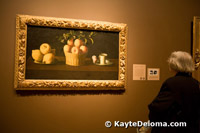 The beauty of the Norton Simon is that you can see virtually every important European artist from the Old Masters to the Impressionists and post-Impressionists all within a few steps of each other. Earlier works on display include Raphael’s Madonna and Child with Book (c.1502-3), Francisco de Zurburan’s Still Life with Lemons, Oranges and a Rose (1633) and Rembrandt van Rijn’s Portrait of a Boy, Presumed to Be the Artist’s Son, Titus (c. 1645-50).
The beauty of the Norton Simon is that you can see virtually every important European artist from the Old Masters to the Impressionists and post-Impressionists all within a few steps of each other. Earlier works on display include Raphael’s Madonna and Child with Book (c.1502-3), Francisco de Zurburan’s Still Life with Lemons, Oranges and a Rose (1633) and Rembrandt van Rijn’s Portrait of a Boy, Presumed to Be the Artist’s Son, Titus (c. 1645-50).
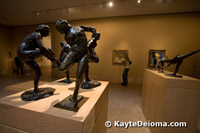 In the popular Impressionists exhibit, you can see Matisse, Renoir, Van Gogh, Manet, Monet, Toulouse-Lautrec, Cezanne and Degas side by side, with multiple examples of each. Vincent van Gogh’s Mulberry Tree is one of the more famous works in the collection, along with the Degas‘ sculpture, Little Dancer, Aged Fourteen (1878-81). The museum has one of the largest collections of works by Edgar Degas, with over 100 paintings, drawings, statues and bronze modčles that the artist used as studies for his dancer figures.
In the popular Impressionists exhibit, you can see Matisse, Renoir, Van Gogh, Manet, Monet, Toulouse-Lautrec, Cezanne and Degas side by side, with multiple examples of each. Vincent van Gogh’s Mulberry Tree is one of the more famous works in the collection, along with the Degas‘ sculpture, Little Dancer, Aged Fourteen (1878-81). The museum has one of the largest collections of works by Edgar Degas, with over 100 paintings, drawings, statues and bronze modčles that the artist used as studies for his dancer figures.
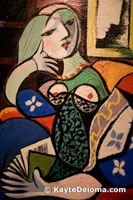 Pablo Picasso, another of the collector’s favorites, dominates the 20th century wing. The museum has 45 of the artist’s sketches, paintings and sculptures. Not all of them are on display at the same time, but the selected works show the diversity of styles Picasso used before developing his signature Cubism. Woman with a Book (1932), one of Picasso’s most recognizable Cubist pieces is presented next to his straightforward pre-cubist oil-and-chalk-on-canvas Bust of a Woman (1923).
Pablo Picasso, another of the collector’s favorites, dominates the 20th century wing. The museum has 45 of the artist’s sketches, paintings and sculptures. Not all of them are on display at the same time, but the selected works show the diversity of styles Picasso used before developing his signature Cubism. Woman with a Book (1932), one of Picasso’s most recognizable Cubist pieces is presented next to his straightforward pre-cubist oil-and-chalk-on-canvas Bust of a Woman (1923).
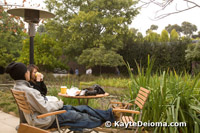 There is a Garden Café and Sculpture Garden at the back of the Main Level. Most of the massive sculptures around the pond are by French artist, Aristide Maillol, including the figure of a woman apparently washing her hair in a river. Unfortunately, they positioned the woman with her hair facing the pond; it’s not in the best position to be viewed from the path.
There is a Garden Café and Sculpture Garden at the back of the Main Level. Most of the massive sculptures around the pond are by French artist, Aristide Maillol, including the figure of a woman apparently washing her hair in a river. Unfortunately, they positioned the woman with her hair facing the pond; it’s not in the best position to be viewed from the path.
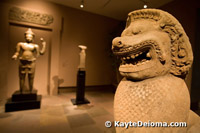 While the paintings and sculptures on the main level have brought the Norton Simon its greatest renown, the lower level also holds abundant treasures. Norton Simon was fascinated by Indian and other South and Southeast Asian antiquities. His collection ranges from the pious to the playful to the erotic as depicted in copper miniatures, cast bronze figures and carved stone statues and architectural features. Gods and goddesses, celestial dancers and amorous couples are the predominant themes. A separate Asian Sculpture Garden is accessible from the Asian galleries on the Lower Level.
While the paintings and sculptures on the main level have brought the Norton Simon its greatest renown, the lower level also holds abundant treasures. Norton Simon was fascinated by Indian and other South and Southeast Asian antiquities. His collection ranges from the pious to the playful to the erotic as depicted in copper miniatures, cast bronze figures and carved stone statues and architectural features. Gods and goddesses, celestial dancers and amorous couples are the predominant themes. A separate Asian Sculpture Garden is accessible from the Asian galleries on the Lower Level.
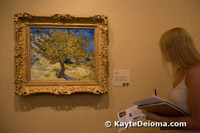 If you have time, take in an orientation film or two in the 300-seat theater. The Art of Norton Simon is a 30 minute film about Norton Simon and his passion for Art. Sister Wendy at the Norton Simon Museum is a delightful tour by the black-robed art scholar, Sister Wendy, of some of the museum’s most famous pieces. The hour-long program created for PBS has been broken into three 20-minute segments for viewing at the museum.
If you have time, take in an orientation film or two in the 300-seat theater. The Art of Norton Simon is a 30 minute film about Norton Simon and his passion for Art. Sister Wendy at the Norton Simon Museum is a delightful tour by the black-robed art scholar, Sister Wendy, of some of the museum’s most famous pieces. The hour-long program created for PBS has been broken into three 20-minute segments for viewing at the museum.
At any given time, 1000 of the 12,000 pieces in the collection are on display at the museum. Even the best known pieces may be rotated out from time to 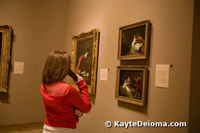 time, so you may not find every painting in the brochure or the videos on the wall when you visit. The paintings are organized by period and by country of origin. The galleries on the main level are all single corridors, so you can go down one side and come back the other and see everything. A self-guided audio tour is available to guide you through the highlights of the exhibit. You dial in the number next to a painting to listen to commentary about it, so you can make the tour as long or short as you like, depending on which pieces you want to hear more about.
time, so you may not find every painting in the brochure or the videos on the wall when you visit. The paintings are organized by period and by country of origin. The galleries on the main level are all single corridors, so you can go down one side and come back the other and see everything. A self-guided audio tour is available to guide you through the highlights of the exhibit. You dial in the number next to a painting to listen to commentary about it, so you can make the tour as long or short as you like, depending on which pieces you want to hear more about.
The Norton Simon Museum
411 West Colorado Blvd.
Pasadena, CA 91105
Phone: (626-449-6840
www.nortonsimon.org

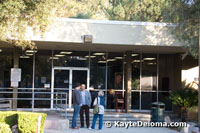 just occasionally look up at the moon and the stars, a tour of the Jet Propulsion Laboratory (JPL) in Pasadena will give you a new perspective on the night sky. It’s not something you can decide to do at the last minute on a rainy day because you have to make reservations in advance, so don’t wait for the rain to make your plans. If it does rain, you’ll need your umbrella for walking between the buildings.
just occasionally look up at the moon and the stars, a tour of the Jet Propulsion Laboratory (JPL) in Pasadena will give you a new perspective on the night sky. It’s not something you can decide to do at the last minute on a rainy day because you have to make reservations in advance, so don’t wait for the rain to make your plans. If it does rain, you’ll need your umbrella for walking between the buildings.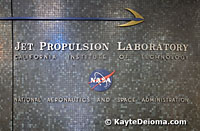 In the 1930s, a group of students at the California Institute of Technology (Caltech) were experimenting with rocket propulsion. After the explosions and the smell got them banned from campus, they found a spot a few miles away in a dry river bed at the foot of the San Gabriel Mountains to set off their rockets, and the Jet Propulsion Laboratory was born. The growing success of their rocket experiments brought in government funding and contracts with the U.S. Army.
In the 1930s, a group of students at the California Institute of Technology (Caltech) were experimenting with rocket propulsion. After the explosions and the smell got them banned from campus, they found a spot a few miles away in a dry river bed at the foot of the San Gabriel Mountains to set off their rockets, and the Jet Propulsion Laboratory was born. The growing success of their rocket experiments brought in government funding and contracts with the U.S. Army.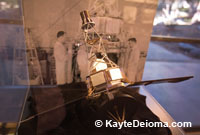 In January 1958, following on the heels of Russia’s Sputnik satellite launch, JPL created the first U.S. satellite to be sent into space, the Explorer I. When the National Aeronautics and Space Administration (NASA) was formed later that year, JPL was invited to be the lead research and development arm for NASA robotics. Since then, JPL has sent over 50 space exploration robots out into our solar system and currently has 17 research modules from satellites to the Mars Exploration Rovers, sending back signals to scientists on the ground. The oldest of these, the Voyager 1 and 2 have been in space since their 1977 launch and continue to send back signals from the far reaches of the universe.
In January 1958, following on the heels of Russia’s Sputnik satellite launch, JPL created the first U.S. satellite to be sent into space, the Explorer I. When the National Aeronautics and Space Administration (NASA) was formed later that year, JPL was invited to be the lead research and development arm for NASA robotics. Since then, JPL has sent over 50 space exploration robots out into our solar system and currently has 17 research modules from satellites to the Mars Exploration Rovers, sending back signals to scientists on the ground. The oldest of these, the Voyager 1 and 2 have been in space since their 1977 launch and continue to send back signals from the far reaches of the universe.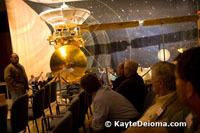 small theater with large scale models of some of the more famous space exploration robots on display. The guide gives a brief history of JPL before showing a short film that gives a refresher course on the solar system and some of the highlights of what the research vessels have found. Exciting footage puts you in the control room with JPL scientists and engineers as the Mars Rover lands successfully on the red planet.
small theater with large scale models of some of the more famous space exploration robots on display. The guide gives a brief history of JPL before showing a short film that gives a refresher course on the solar system and some of the highlights of what the research vessels have found. Exciting footage puts you in the control room with JPL scientists and engineers as the Mars Rover lands successfully on the red planet.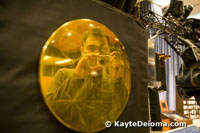 Voyager, with its golden record on the front, conceived by Carl Sagan. You can also hear a piece of the recording which contains greetings in 60 languages, bits of music and other cultural sounds of the 70s, and see the 117 pictures that were chosen to represent humanity on earth. In case there is intelligent life out there somewhere, pictographic instructions are etched on the record cover describing how to play it. Other models on display include the Mars Global Surveyor, the Mars Odyssey Orbiter, and the Cassini Spacecraft andHuygens Probe, currently circling Saturn and its moon, Titan.
Voyager, with its golden record on the front, conceived by Carl Sagan. You can also hear a piece of the recording which contains greetings in 60 languages, bits of music and other cultural sounds of the 70s, and see the 117 pictures that were chosen to represent humanity on earth. In case there is intelligent life out there somewhere, pictographic instructions are etched on the record cover describing how to play it. Other models on display include the Mars Global Surveyor, the Mars Odyssey Orbiter, and the Cassini Spacecraft andHuygens Probe, currently circling Saturn and its moon, Titan.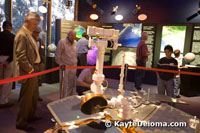 Next to the theater is the JPL Museum. A full scale Mars Exploration Rover and many smaller scale models of spacecraft are on display. Globes of planets and moons indicate named features that have been documented by the space explorers. While older members of our group honed in on trying to find their houses on a large satellite map of Southern California, James, who looked to be about 5, raced from model to globe to model calling to his friend, “Thunder, you gotta see this!”
Next to the theater is the JPL Museum. A full scale Mars Exploration Rover and many smaller scale models of spacecraft are on display. Globes of planets and moons indicate named features that have been documented by the space explorers. While older members of our group honed in on trying to find their houses on a large satellite map of Southern California, James, who looked to be about 5, raced from model to globe to model calling to his friend, “Thunder, you gotta see this!”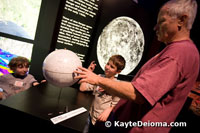 Large scale photos of the birth and death of stars, taken from the Hubble Space Telescope, adorn one wall. A sample of Silica Aerogel, also known as “solid blue smoke” has a certificate from the Guinness Book of World Records for being the lightest solid substance in the world. In the next museum display, they project a neat little light show on blocks of the smoky substance. In space, among other things, they use it to capture particle samples.
Large scale photos of the birth and death of stars, taken from the Hubble Space Telescope, adorn one wall. A sample of Silica Aerogel, also known as “solid blue smoke” has a certificate from the Guinness Book of World Records for being the lightest solid substance in the world. In the next museum display, they project a neat little light show on blocks of the smoky substance. In space, among other things, they use it to capture particle samples.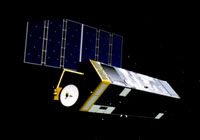 From the video, you know that this nerve center of operations is filled with wall to wall scientists and engineers when it’s time for a launch or landing. It looks a lot like other NASA control rooms you see in the news and the movies for the launch of manned space missions. On an ordinary day, most of the three rows of consoles in the main room and more work stations in a windowed area off to the side are unoccupied. On our visit, five people are at their monitors, keeping track of all the unmanned spacecraft in the universe.
From the video, you know that this nerve center of operations is filled with wall to wall scientists and engineers when it’s time for a launch or landing. It looks a lot like other NASA control rooms you see in the news and the movies for the launch of manned space missions. On an ordinary day, most of the three rows of consoles in the main room and more work stations in a windowed area off to the side are unoccupied. On our visit, five people are at their monitors, keeping track of all the unmanned spacecraft in the universe.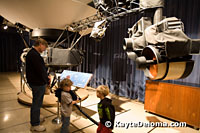 Using flat planets stuck on a carpet wall, we get a lesson in space distances. The comparison that most resonates with me is the time it takes to send and receive messages. It takes 1.5 seconds for a message to reach the moon, which is a mere 384,000 miles from Earth. It takes over 14 hours for a message to travel to the Voyager 1 spacecraft. At 10 billion miles from Earth and counting, it is the most distant human creation in the universe. Traveling at about 39,000 miles per hour, Voyager 1 should reach the outer boundary of our solar system within the next 10 years. Hopefully its 1977 nuclear batteries will still be running to tell us what’s out there.
Using flat planets stuck on a carpet wall, we get a lesson in space distances. The comparison that most resonates with me is the time it takes to send and receive messages. It takes 1.5 seconds for a message to reach the moon, which is a mere 384,000 miles from Earth. It takes over 14 hours for a message to travel to the Voyager 1 spacecraft. At 10 billion miles from Earth and counting, it is the most distant human creation in the universe. Traveling at about 39,000 miles per hour, Voyager 1 should reach the outer boundary of our solar system within the next 10 years. Hopefully its 1977 nuclear batteries will still be running to tell us what’s out there.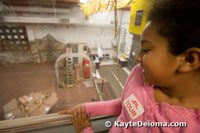 glassed-in walkway you can look down on a Mars simulation room where a replica of the Mars Rover is used to test out program directions before they are sent to the Rovers on Mars. If there is a problem with the Spirit or Opportunity Rovers, the problem is recreated and solved with the replica Rover and then the solution is uploaded to the research vehicles on Mars. It takes about 15 minutes to send a signal to Mars – a lot closer than the Voyager 1.
glassed-in walkway you can look down on a Mars simulation room where a replica of the Mars Rover is used to test out program directions before they are sent to the Rovers on Mars. If there is a problem with the Spirit or Opportunity Rovers, the problem is recreated and solved with the replica Rover and then the solution is uploaded to the research vehicles on Mars. It takes about 15 minutes to send a signal to Mars – a lot closer than the Voyager 1.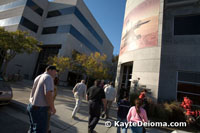 f you’re traveling with a group of 10 or more, special tours can be arranged outside of the Wednesday public tours. JPL also holds an annual two-dayOpen House in May where the scientists come out of their labs and bring their projects to demonstrate, from Mars Exploration Rovers and other robots to thermal imaging equipment, solar telescopes and space suits. There are also monthly lectures on space and technology-related topics that are open to the public.
f you’re traveling with a group of 10 or more, special tours can be arranged outside of the Wednesday public tours. JPL also holds an annual two-dayOpen House in May where the scientists come out of their labs and bring their projects to demonstrate, from Mars Exploration Rovers and other robots to thermal imaging equipment, solar telescopes and space suits. There are also monthly lectures on space and technology-related topics that are open to the public.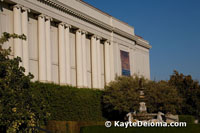 At the edge of the affluent community of San Marino, bordering on Pasadena sits the grand estate of Henry E. Huntington, a railroad and utilities magnate who bought the property in 1903 and used it as a base for developing the San Gabriel Valley. Huntington and his second wife, Arabella, filled the mansion they built on the grounds in 1911 with a world-class collection of British and French art.
At the edge of the affluent community of San Marino, bordering on Pasadena sits the grand estate of Henry E. Huntington, a railroad and utilities magnate who bought the property in 1903 and used it as a base for developing the San Gabriel Valley. Huntington and his second wife, Arabella, filled the mansion they built on the grounds in 1911 with a world-class collection of British and French art.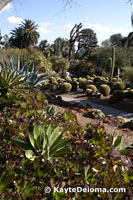 There wasn’t enough room in the house to bring Huntington’s extensive book collection from New York, so he built a separate library building to house the thousands of first editions, historic documents and volumes on the American West. It took multiple railroad cars to bring the collected works to California when the building was finished in 1921. Meanwhile, out on the ranch, a landscape gardener by the name of William Hertrich was busy turning farmland into a showcase of diverse botanical specimens from the local deserts and around the world. Following Huntington’s instructions, the non-profit trust that he formed opened the Huntington Library, Art Collections and Botanical Gardens to the public in 1928, a year after his death.
There wasn’t enough room in the house to bring Huntington’s extensive book collection from New York, so he built a separate library building to house the thousands of first editions, historic documents and volumes on the American West. It took multiple railroad cars to bring the collected works to California when the building was finished in 1921. Meanwhile, out on the ranch, a landscape gardener by the name of William Hertrich was busy turning farmland into a showcase of diverse botanical specimens from the local deserts and around the world. Following Huntington’s instructions, the non-profit trust that he formed opened the Huntington Library, Art Collections and Botanical Gardens to the public in 1928, a year after his death.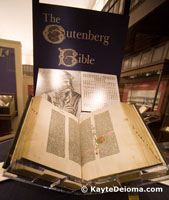 scholars and researchers by special arrangement. For the rest of us, the Library Galleries display some of the most famous pieces along with rotating exhibits.
scholars and researchers by special arrangement. For the rest of us, the Library Galleries display some of the most famous pieces along with rotating exhibits.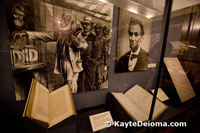 4th Earl of Ellsmere. A double-elephant folio edition of Audubon’s Bird’s of America and early editions of Shakespeare’s works are other rare finds. In the 19th Century British and American Literature section, there are personal letters from Charlotte Bronte, Henry David Thoreau, Walt Whitman and Harriet Beecher Stowe. American history documents include papers related to Abraham Lincoln and the 13th Amendment to the Constitution. The History of the American West is laid out in personal letters, articles, books and photos.
4th Earl of Ellsmere. A double-elephant folio edition of Audubon’s Bird’s of America and early editions of Shakespeare’s works are other rare finds. In the 19th Century British and American Literature section, there are personal letters from Charlotte Bronte, Henry David Thoreau, Walt Whitman and Harriet Beecher Stowe. American history documents include papers related to Abraham Lincoln and the 13th Amendment to the Constitution. The History of the American West is laid out in personal letters, articles, books and photos.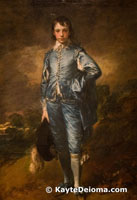 Georgian mansion. However, the mansion is undergoing renovations until summer of 2008, so the French and British art normally on view in the rooms of the main house are temporarily on display in the Erburu Gallery. This includes an impressive group of elegant full-length Grand Manner portraits by Gainsborough, Romney, Reynolds and Lawrence. Two favorites, Gainsborough’s Blue Boy and Lawrence’s Pinkie, which traditionally hung side by side in the mansion, occupy different rooms in the Erburu Galley.
Georgian mansion. However, the mansion is undergoing renovations until summer of 2008, so the French and British art normally on view in the rooms of the main house are temporarily on display in the Erburu Gallery. This includes an impressive group of elegant full-length Grand Manner portraits by Gainsborough, Romney, Reynolds and Lawrence. Two favorites, Gainsborough’s Blue Boy and Lawrence’s Pinkie, which traditionally hung side by side in the mansion, occupy different rooms in the Erburu Galley.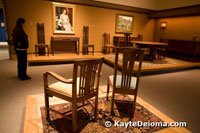 There are several rooms in the Scott Gallery dedicated to the Arts and Crafts Movement in architecture and furnishings. Highlights include three Frank Lloyd Wright chairs and a room devoted to the furniture, textiles and other designs of William Morris and his followers. The largest gallery showcases the work of local architects Henry and Charles Greene who built the Gamble House and many other notable Pasadena properties. There are two fully furnished dining areas with tables, chairs, sideboards, cupboards and leaded glass lamps.
There are several rooms in the Scott Gallery dedicated to the Arts and Crafts Movement in architecture and furnishings. Highlights include three Frank Lloyd Wright chairs and a room devoted to the furniture, textiles and other designs of William Morris and his followers. The largest gallery showcases the work of local architects Henry and Charles Greene who built the Gamble House and many other notable Pasadena properties. There are two fully furnished dining areas with tables, chairs, sideboards, cupboards and leaded glass lamps.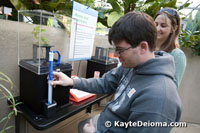 You can don your rain gear and explore the 120 acres divided into 12 themed gardens or you can escape into the Rose Hills Foundation Conservatory for Botanical Science which opened in 2005. Designed to appeal to middle school students, the glass-enclosed science lab allows kids and adults to zoom in on plants and bugs with magnifying video cameras that show the image on large LCD screens. You can test the sugar content of different plant nectars, see how helicopter and parachute seeds are carried by the wind, discover up close why burrs get caught in your
You can don your rain gear and explore the 120 acres divided into 12 themed gardens or you can escape into the Rose Hills Foundation Conservatory for Botanical Science which opened in 2005. Designed to appeal to middle school students, the glass-enclosed science lab allows kids and adults to zoom in on plants and bugs with magnifying video cameras that show the image on large LCD screens. You can test the sugar content of different plant nectars, see how helicopter and parachute seeds are carried by the wind, discover up close why burrs get caught in your 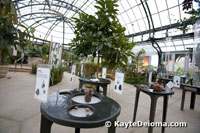 socks, measure the nutrient levels in plant water and generally touch and smell different kinds of plants. If you’ve been through the Art Galleries, you can look for the plants that were in some of the paintings. The popular carnivorous bug-eating plant lab occupies one whole end of the Conservatory. Behind the glass-domed building is the Teaching Greenhouse with more hands-on discovery activities for kids and families.
socks, measure the nutrient levels in plant water and generally touch and smell different kinds of plants. If you’ve been through the Art Galleries, you can look for the plants that were in some of the paintings. The popular carnivorous bug-eating plant lab occupies one whole end of the Conservatory. Behind the glass-domed building is the Teaching Greenhouse with more hands-on discovery activities for kids and families.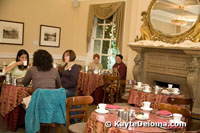 English Tea is served Tuesday through Sunday in the Rose Garden Tea Room. Your English tea consists of a pot of tea, a basket of mini scones and a buffet of bite-size tea sandwiches and mini pastries. The Rose Garden Café on the back of the Tea Room serves deli sandwiches, grill items, snacks and beverages. During the summer you need an advance reservation for the Tea Room, but on a weekday in winter, you can probably walk in or get a reservation on site. No reservations are needed at the Café.
English Tea is served Tuesday through Sunday in the Rose Garden Tea Room. Your English tea consists of a pot of tea, a basket of mini scones and a buffet of bite-size tea sandwiches and mini pastries. The Rose Garden Café on the back of the Tea Room serves deli sandwiches, grill items, snacks and beverages. During the summer you need an advance reservation for the Tea Room, but on a weekday in winter, you can probably walk in or get a reservation on site. No reservations are needed at the Café.